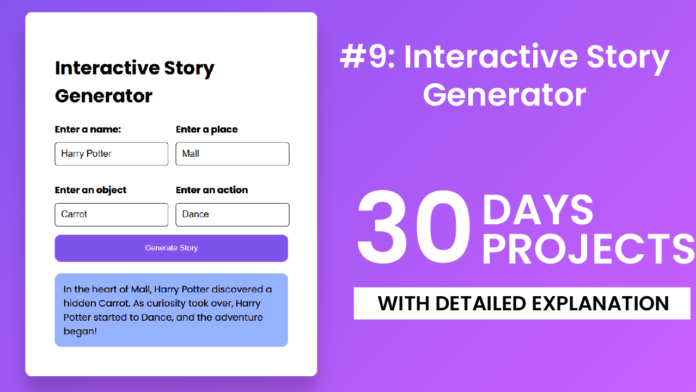Creating interactive and fun web applications is a great way to practice your frontend skills. In this blog post, we’ll walk through how to build a simple Interactive Story Generator using HTML, CSS, and JavaScript. Users can input custom words, and the app will create a unique short story using those inputs.
HTML: Structuring the Page:
The HTML file lays the foundation for our project. It includes input fields for a name, place, object, and action — all necessary for building a personalized story. Each input is wrapped in a <div> with a <label> for accessibility and user guidance. There’s also a button to trigger the story generation and a <div> with the id="story" where the final output is displayed. The structure is clean, semantic, and easy to follow.
<!DOCTYPE html>
<html lang="en">
<head>
<meta name="viewport" content="width=device-width, initial-scale=1.0" />
<title>Interactive Story Generator</title>
<link rel="stylesheet" href="style.css" />
</head>
<body>
<div class="container">
<h1>Interactive Story Generator</h1>
<div class="wrapper">
<div>
<label for="name">Enter a name:</label>
<input type="text" id="name" placeholder="Type a name" required />
</div>
<div>
<label for="place">Enter a place</label>
<input type="text" id="place" placeholder="Type a place" required />
</div>
<div>
<label for="object">Enter an object</label>
<input
type="text"
id="object"
placeholder="Type an object"
required
/>
</div>
<div>
<label for="action">Enter an action</label>
<input
type="text"
id="action"
placeholder="Type an action"
required
/>
</div>
</div>
<button id="generateStory">Generate Story</button>
<div id="story" class="story"></div>
</div>
<script src="script.js"></script>
</body>
</html>
CSS: Styling the Interface
The CSS file is responsible for making the application visually appealing. The background uses a linear gradient for a vibrant and modern look. The .container class centers the form on the screen and adds padding, a border radius, and a soft shadow for a card-like appearance. The .wrapper class uses a grid layout to arrange input fields in two columns. Input fields and buttons are styled consistently to maintain a smooth user experience. The .story div is styled with a different background color and rounded corners and is initially hidden until a story is generated.
body {
font-family: "Poppins", sans-serif;
box-sizing: content-box;
height: 100vh;
background: linear-gradient(135deg, #8052ec, #d161ff);
}
.container {
position: absolute;
width: min(400px, 90vw);
transform: translate(-50%, -50%);
top: 50%;
left: 50%;
background-color: #ffffff;
padding: 50px;
border-radius: 10px;
box-shadow: 0 30px 30px rgba(0, 0, 0, 0.2);
}
.wrapper {
display: grid;
grid-template-columns: 1fr 1fr;
gap: 15px;
}
input {
font-size: 16px;
width: 90%;
padding: 10px;
margin-bottom: 15px;
border-radius: 5px;
border: 1.5px solid #000000;
}
label {
font-weight: bold;
display: block;
margin-bottom: 10px;
}
button {
width: 100%;
background-color: #8052ec;
cursor: pointer;
color: #ffffff;
padding: 15px 0;
outline: none;
border: none;
border-radius: 10px;
}
button:hover {
background-color: #3f0eb0;
}
.story {
margin-top: 20px;
padding: 15px;
background-color: #96b2ff;
border-radius: 10px;
display: none;
}
JavaScript: Making It Interactive
The JavaScript file ties everything together with interactivity. An event listener on the “Generate Story” button collects user input values from the form. If any field is empty, it triggers an alert. Otherwise, it randomly selects a story template from a pre-defined array and inserts the user’s inputs into placeholders. The chosen story is then displayed in the previously hidden .story div. Console logs are also included for debugging purposes, allowing developers to monitor inputs and generated stories.
document.getElementById("generateStory").addEventListener("click", function () {
let name = document.getElementById("name").value.trim();
let place = document.getElementById("place").value.trim();
let object = document.getElementById("object").value.trim();
let action = document.getElementById("action").value.trim();
let storyDiv = document.getElementById("story");
console.log(name, place, object, action);
if (name === "" || place === "" || object === "" || action === "") {
alert("Please fill in all fields");
}
let stories = [
`One day, ${name} went to ${place} and found a mysterious ${object}. Without thinking, ${name} decided to ${action}, and something magical happened!`,
`In the heart of ${place}, ${name} discovered a hidden ${object}. As curiosity took over, ${name} started to ${action}, and the adventure began!`,
`${name} was walking through ${place} when suddenly a ${object} appeared. Without hesitation, ${name} chose to ${action}, leading to an unforgettable experience!`,
`While exploring ${place}, ${name} saw a sparkling ${object}. As soon as they touched it, they were transported to a new world where they had to ${action} to find a way back home!`,
`One night at ${place}, ${name} found an ancient ${object}. The moment they tried to ${action}, the object began to glow, revealing a hidden secret!`,
`At ${place}, ${name} was given a strange ${object} by an old wise person. They were told that if they ${action} at the right moment, something incredible would happen!`,
`${name} was cleaning their attic when they stumbled upon an old ${object}. Curious, they decided to ${action}, and suddenly, they were taken on a journey through time!`,
];
let randomStory = stories[Math.floor(Math.random() * stories.length)];
console.log(randomStory);
storyDiv.innerText = randomStory;
storyDiv.style.display = "block";
});
Conclusion
This Interactive Story Generator is a fun project that demonstrates how HTML, CSS, and JavaScript work together to build a simple yet engaging web app. It’s perfect for beginners looking to understand the basics of DOM manipulation, event handling, and dynamic content generation. With a little creativity, you can expand this project by adding more story templates, sound effects, or even illustrations. Happy coding!


